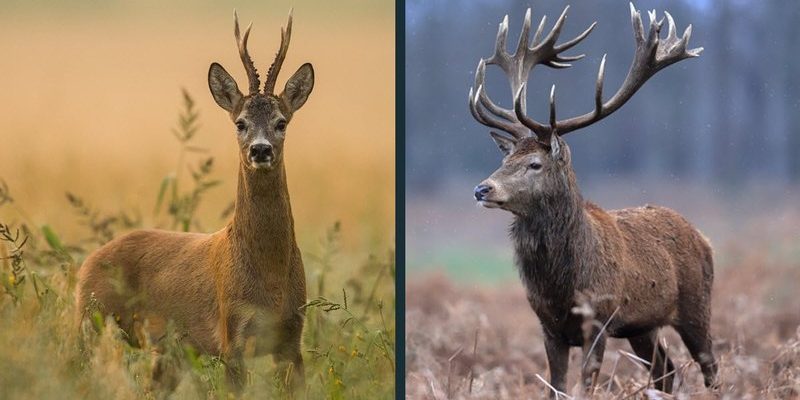![Comparing The Red Deer Vs. [Similar Species]](https://gudri.com/wp-content/uploads/2025/06/Comparing_The_Red_Deer_Vs___Similar_Species__image_0.jpg)
Both the red deer and elk are fascinating animals with rich histories and unique characteristics. Understanding these differences can enhance your appreciation for wildlife. So, whether you’re an animal lover, a wildlife photographer, or just curious about nature, let’s dive deep into the world of these stunning creatures.
Physical Characteristics
When it comes to size and appearance, both the red deer and elk are impressive. However, there are some noticeable differences. Red deer typically stand about 3.3 to 4.5 feet tall at the shoulder, weighing between 400 to 500 pounds. Their coats are usually a reddish-brown, especially during the summer, which helps them blend into their forested habitats. Imagine spotting one in the wild; their warm tones blend beautifully with the underbrush.
On the other hand, elk are generally larger, standing up to 5 feet at the shoulder, and can weigh around 600 to 1,100 pounds. They have a lighter, tan-colored coat and a darker mane. The difference in size can be quite striking, especially when you see them grazing in a meadow—elk often command attention simply due to their sheer bulk and size.
Habitat Preferences
Red deer and elk have different habitat preferences that reflect their unique lifestyles. Red deer thrive in forested areas, often found in the mountainous regions of Europe and parts of Asia. They prefer environments with dense foliage, where they can keep hidden from predators and easily find food.
Elk, on the other hand, are more versatile in their habitat choices. They can be found in a variety of environments, including forests, grasslands, and even urban areas. You might spot them in the Rocky Mountains or the open fields of North America, where they roam in herds and graze on grass, shrubs, and bark. Their adaptability helps them thrive in diverse climates.
Behavior and Social Structure
When it comes to behavior, red deer and elk showcase different social structures. Red deer tend to form smaller groups, especially outside of the mating season. Usually, you’ll see females (hinds) and their young hanging out together, while males (stags) are more solitary or form small bachelor groups. It’s almost like they enjoy their own space, only coming together during the rutting season when the males compete for mates.
Elk are much more social. They form larger herds, especially during the winter months when they band together to stay warm and protect each other from predators. Their sociability is fascinating to watch—seeing a herd of elk grazing together or moving gracefully across a valley can feel like catching a glimpse of a well-organized ballet in nature.
Breeding and Reproduction
Breeding seasons for red deer and elk both occur during the fall, but the ways they court their mates can be quite different. During this time, you can often hear the booming calls of male red deer echoing through the forests. These calls help establish dominance and attract females, leading to dramatic displays of strength and vigor. It’s like nature’s version of a dance-off!
Elk have a similar rutting season but incorporate a unique element: the bugle. The males produce a high-pitched call, which resonates across large distances. This not only helps attract females but also warns other males to stay away. Watching a male elk bugle is mesmerizing—it’s a display of power and attraction rolled into one.
Diet
Both species are herbivores, but their diets can differ slightly based on their habitats. Red deer mainly eat grasses, herbs, and shrubs. They’re browsers, meaning they like to nibble on leaves from trees and bushes. Imagine them delicately picking their way through a forest, sniffing out the tastiest greens among the foliage.
On the flip side, elk have a more varied diet due to their habitat. They enjoy a mix of grasses, shrubs, and even tree bark—especially in winter when food is scarce. Their ability to adapt their diet based on availability allows them to thrive in different environments. It’s interesting how they can switch from munching on tender grass in the summer to gnawing on tough bark in the cold months.
Conservation Status and Threats
Both the red deer and elk have faced threats over the years, but their conservation statuses differ. Red deer have been relatively stable due to various conservation efforts, especially in Europe. However, they still face challenges such as habitat loss and hunting in certain regions.
On the other hand, elk populations have seen fluctuations. In the past, overhunting significantly reduced their numbers, but with conservation measures in place, they’ve made a comeback in many areas. Both species are under continual pressure from habitat encroachment and climate change, which makes understanding and protecting them crucial for preserving biodiversity.
At the end of the day, comparing the red deer and elk highlights the incredible diversity found within the deer family. While they share common traits, their differences in size, habitat, behavior, and diet paint a vivid picture of how species adapt to their environments.
So, whether you’re lucky enough to spot a magnificent red deer peeking through the trees or an elk striding proudly across a meadow, remember that each animal has its own story and role in the ecosystem. Nature is a tapestry of life, and every thread counts. Take the time to appreciate these beautiful creatures and their habitats—you’ll never look at the woods the same way again!

